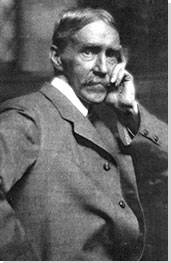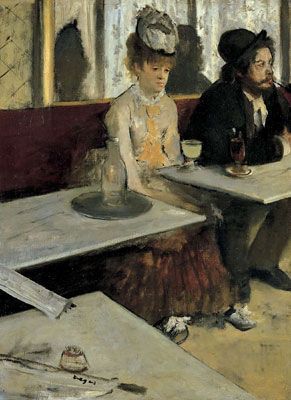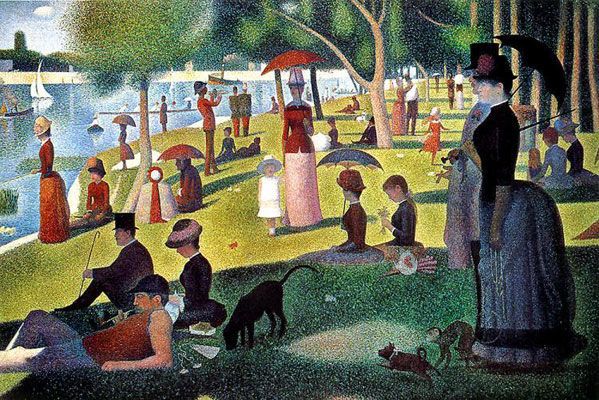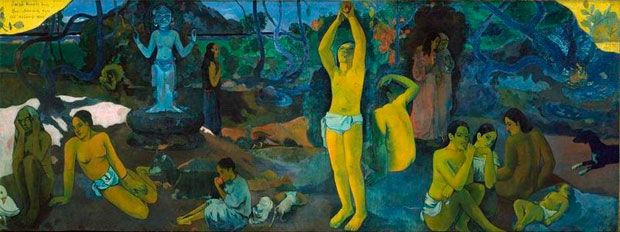Summary of Maurice Prendergast
Through his trips to Europe, Prendergast encountered and absorbed many new ideas relating to the practices and production of art. He took these with him back to the USA where he incorporated them into his own work to create a unique and personal style which helped to introduce and popularize Modernism in America. Prendergast continued to develop his art throughout his life, trialing new mediums and experimenting widely with notions of color and form. Fascinated by people and busy scenes, his work is reflective of contemporary ideas pertaining to health, leisure, and the benefits of the outdoors and he often presented a utopian take on the sights he painted.
All of his work contained a sense of energy and motion. In addition, his paintings became increasingly abstract as his career progressed.
Accomplishments
- Prendergast drew inspiration from the work of European Post Impressionists and he was a leading figure in introducing these new concepts and styles to American audiences. He was particularly interested in color and his use of bold pigments make a vibrant statement throughout his work, highlighting emotional and pictorial elements.
- Although working in a range of mediums including oils and monotypes (a print taken from a design created in oil paint or printing ink on glass or metal), he often painted with watercolors and is known for his expertise with these, particularly his flowing technique and unusual use of strong colors.
- The majority of Prendergast's work depicts scenes of contemporary life, focusing on groups of people in outdoor locations - the street, beach and park. He was particularly interested in painting women and captured fashionable clothing and accessories with a keen eye for detail. The themes of his work inspired later generations of artists to record leisure activities in a similar manner.
- Prendergast created a large number of monotypes and the dissemination of these helped to promote the idea of fine art color prints to the wider public.
Important Art by Maurice Prendergast
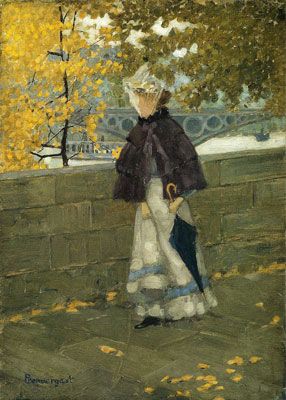
Along the Seine
Along the Seine was created during Prendergast's first trip to Paris where he was exposed to a wide range of new artistic styles. The majority of his work at this period was painted in watercolors and this image is an important early example of his use of oils.
When not attending art classes he spent a great deal of his time absorbing scenes of Parisian life which he turned into subjects for his paintings, setting a precedent for his later work. The fashionably dressed woman strolling along the river provides an early example of Prendergast's focus on leisure activities and portrayals of clothing. The colors are muted apart from the yellow leaves on the tree and ground and this hints at an early exploration of the impact of color within a composition.
The impact of French Impressionism is present in the image in terms of both style and subject matter and this can be attributed to the influence of painters such as Édouard Manet and the American, James McNeill Whistler.
Oil on canvas - Collection of Whitney Museum of America Art, New York, New York
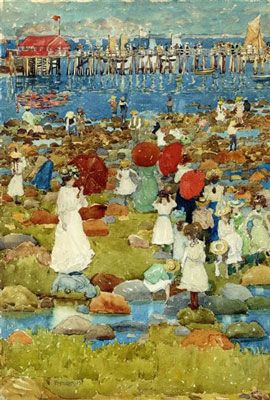
The Stony Beach, Ogunquit
This work provides a fine example of the crowd scenes that Prendergast often painted, in this instance a sunny afternoon on a Massachusetts beach. Prendergast painted extensively in New England depicting the social spaces of beaches and parks. Working in watercolor, he demonstrates his mastery over the medium, combining detail with a freedom of brushwork. More experimental in style than some of his earlier work, this image is a sensitive response to Post Impressionism.
The complex arrangement exhibits a charming sense of innocence combined with a formal sophistication. The figures are arranged in a flowing line throughout the picture and this rhythm is emphasized by the distribution of vibrant blocks of color - parasols and bright dresses stand out against the other white figures and the rocky shoreline. The red elements of the image draw the eye upwards to the top left of the painting and the flowing lines of the white dresses are reflected in the sails of the yachts. The jewel colors, flattened perspective and decorative style suggests comparisons with tapestry work or mosaics.
Watercolor and pencil on paper - Private Collection
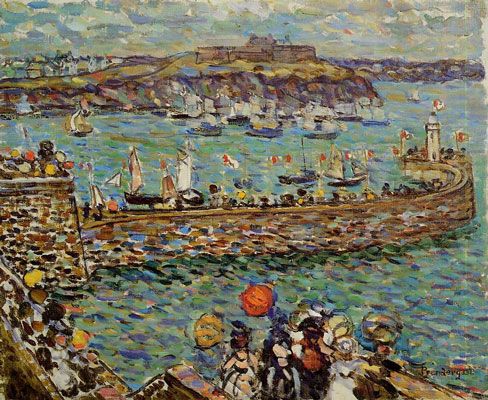
Lighthouse at St. Malo
This is one of a number of works Prendergast created based on sights he saw during a trip to St Malo, France in 1907. The same sinuous shapes seen in earlier works continue to be visible but the influence of Pointillism and Fauvism can be noted in the vibrant blues and greens and loose brushstrokes. The group of figures in the foreground and the rocky headland in the background form a static framework to the curving quay which carries the observer's eye across the painting from left to right.
Prendergast selected paintings from the St Malo series to display in 'The Eight' exhibition of 1908.
Oil on canvas - Collection of The William Benton, Museum of Art, The University of Connecticut, Storrs, Connecticut
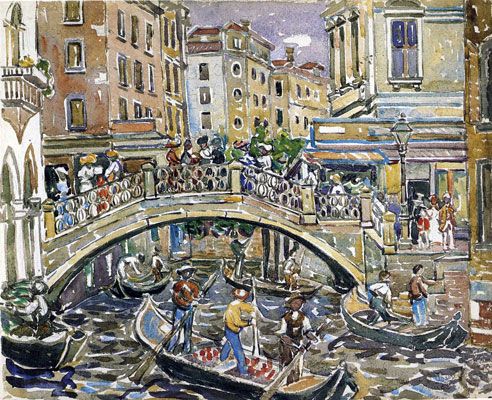
Canal
Prendergast toured Italy during the period 1911-12 and this resulted in a burst of activity. He produced many watercolors including more than twenty depictions of the canal bridges in Venice. Fascinated by the colors and sights of the country, he described their effect on his creativity, "Italy is the place for ideas to dance a high step on the paint box."
The Canal is an important example of how his Italian works focused heavily on the architecture of the cities he visited. Here the muted colors of the Venetian buildings form a dominant and geometric framework for the livelier movement of the gondolas and boatmen in the foreground. The curve of the bridge, with its static crowd, forms a barrier between the two elements. The harshness of this delineation is alleviated by the repetition of the splashes of ochre which carry the eye between the two areas. The color occurs in the gondolier's blouse in the foreground and is then repeated on various facets of the buildings.
Watercolor and pencil on paper - Collection of Munson-Williams-Proctor Institute Museum of Art, Utica, New York
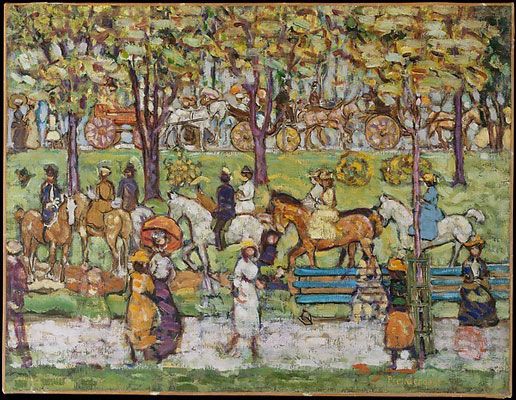
Central Park
This work was finished shortly after Prendergast's move to New York in 1914, although it may have been started some years earlier and reworked. The three horizontal bands running across the painting represent the division of routes in the park between carriages, riders and pedestrians with the vertical elements of the trees linking the bands. There is a strong sense of movement from left to right and right to left across the painting with points of stasis halting the movement at the end of each band so that the eye is not drawn off the edge of the canvas. Despite the muted palette employed there is a pleasing sense of festivity attached to the image.
The figures are presented in a less realistic manner than in earlier works and the objects, while still distinguishable, give way to larger, more abstract forms of densely-packed color. This image demonstrates Prendergast's continued development and experimentation even later in his career as an artist.
Oil on canvas - Collection of The Metropolitan Museum of Art, New York, New York
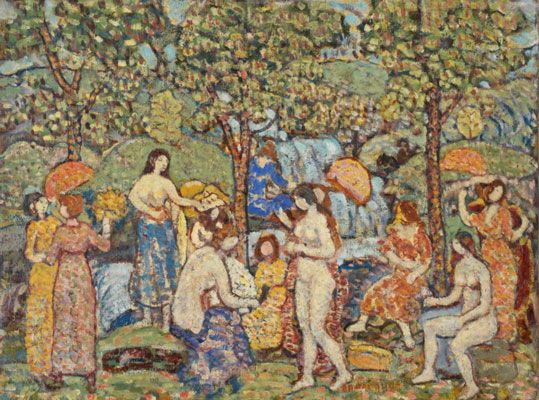
Idyll
The loosely rendered figures in this work are characteristic of Prendergast's later style in which color and form became more important than realism.
Rich in symbolism, as well as references to classical imagery, this painting highlights Prendergast's command of art history and his deep understanding of European artists and works.
According to Richard Wattenmaker, in this one work alone "[...]Prendergast translated his understanding of Florentine frescoes, Giorgione, Gauguin's elegant Tahitian versions of the Greeks, Renoir's nudes and nude groups, and Puvis de Chavannes into a graceful frieze, combining clothed, semiclothed, and nude figures in a rhythmic sequence recalling but not resembling Gauguin's Where Do We Come From? What Are We? Where Are We Going? of 1897. The dry, fresco-like sparkle of color, the emphasis on rich, granular built-up pigment, such as that found in Cézanne's bathers and landscapes that Maurice had scrutinized, merged its rugged texture with an appealing, almost anticlassical "awkwardness" of drawing, with its compact, unconventional placement of three-dimensional figures against a screenlike background."
Oil on canvas - Collection of The Barnes Foundation, Merion Station, Pennsylvania
Biography of Maurice Prendergast
Childhood
Maurice Prendergast was born to an American mother and Canadian father at the family's sub-Arctic trading post in St John's, Newfoundland.
The oldest of five siblings, he suffered early familial loss including a still-born younger sister and later, when he was six, the death of her twin brother Richard. His own twin sister, Lucy, died when he was in his late teens. Perhaps it was these deaths that contributed to his lifelong attachment to his brother Charles, five years his junior.
While little is documented about Prendergast's younger years, it is known the family moved to Boston when he was ten. At 14 he went to work in a dry goods store as a package wrapper.
Education and Early Training
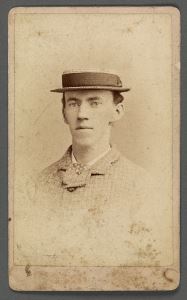
When not at work, Prendergast studied mechanical drawing and attended free evening art classes. Later, he worked as an apprentice, lettering cards and by the age of 28 he had gained employment as a designer of cards and signs for a Boston firm.
Prendergast did not formally study art until an extended stay in Paris, beginning in January 1891, where he attended two prestigious schools, the Académies Julian and Colarossi. The watercolors he created during his stay, mostly scenes of Paris life, were well received and several of his sketches were selected to be reproduced in the magazine, The Studio, in 1893. Unfortunately, at the time the public did not know the works were by Prendergast as they had been stolen from his studio and submitted under the name of Michael Dignam. It was also during this stay, that he began a series of monotypes that were, in part, inspired by the works of Degas and Pissarro.
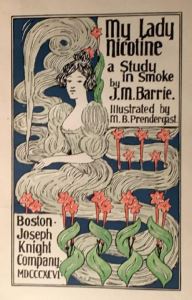
After four years abroad, Prendergast returned home and quickly established himself as an artist by exhibiting his works in cities including Boston, Chicago, and New York. In addition, he took on commissions to create posters and book illustrations. His most notable being the 1895 James M. Barrie book, My Lady Nicotine: A Study in Smoke, for which he created the cover image and a further 138 illustrations.
Family was important to Prendergast, he never married and lived with his brother Charles throughout his life. Charles (who was also an artist) played an integral role in supporting his brother's career by starting a frame-making business which allowed Prendergast to come into contact with wealthy collectors as well as providing financial stability for them. The two, while reserved, were known for their charismatic personalities and looks. Of the brothers, one friend said, "They were odd and wonderful people, Mr. Maurice and Charlie. They always looked so clean and jaunty. There was something Peter Pan about both of them, [they] never quite grew up."
Mature Period
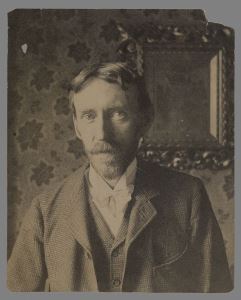
Health issues hampered Prendergast's work throughout his life. By 1905 he had developed severe hearing problems and having tried medical treatments without success, he temporarily put his work aside to join a swimming club called the L Street Brownies in the hope that an intense course of outdoor swimming and exposure to the sun would help delay the loss. Ultimately this, nor any other cure, would prove successful.
In 1907 Prendergast returned to Europe where he drew inspiration from the work of artists such as Cézanne, Matisse, and Seurat stating "I am so chocked full of the exhibitions here I don't know what influence it will have after I am once more home." His work subsequently began to focus more on explorations of color conveyed in a Post Impressionistic and often Pointillist style.
Through his exhibitions in New York, Prendergast became affiliated with a group of painters known as 'The Eight'. This was a short-lived association of American artists who protested about the restrictive display policies of the National Academy of Design. Led by Robert Henri, other members included Arthur Davies, William Glackens, Ernest Lawson, George Luks, Everett Shinn, and John Sloan. Whilst all of the artists in the group sought to bring art into closer touch with daily life, Prendergast's work was unique in that it utilized color more freely and lacked the grittier, often darker, aspects of urban realities seen in the works of members such as Henri or Glackens.
The group only formally exhibited once (in 1908) but the exhibition helped to secure Prendergast's position as an interesting and innovative artist. This was acknowledged by a reviewer from the Newark Evening News who, after visiting the exhibition, wrote, "do not think that Prendergast has spoken the final word with his Cézanne technique. We will hear more of it when the influence of France upon the young artists studying there now becomes better known. Prendergast has sacrificed much in adopting it, but then, like his comrades, he has the satisfaction of being true to himself."
Many artists associated with 'The Eight' later became part of a larger movement known as the Ashcan School, which focused on Realism. Whilst, remaining friends with these artists, Prendergast's developing style prevented a formal affiliation with this new group and led him on a more solitary journey.
Prendergast's work was also included in the pivotal Armory Show of 1913 and while his paintings were considered modern for American audiences, he did not embrace the Cubist style that was the most controversial aspect of the show. Unsure of this new movement, which he could appreciate but would not adopt, he famously stated, "Too much - O my God! - art here."
Late Period
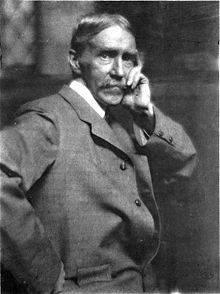
In 1914 Prendergast settled in New York with his brother where he found himself in high demand with collectors. The last decade of his career was important because it was during this period that he made his largest paintings. He also started to embrace new subjects including classical themes and symbolic imagery.
Despite declining health and the complete loss of hearing, Prendergast continued to paint for as long as he was physically able. He received a prestigious honor, shortly before his death, the Corcoran Bronze Medal, for a work in a December 1923 exhibition at the Corcoran Gallery of Art in Washington, D.C. Seriously ill and in hospital suffering from circulation issues, he was unable to accept the award in person, but humbly responded that "I'm glad they've found out I'm not crazy, anyway,".
In February 1924, shortly after undergoing surgery, Prendergast died peacefully in the hospital. Characteristic of the private way he lived his life he was cremated without fanfare the day after his death.
The Legacy of Maurice Prendergast
Maurice Prendergast played a key role in the development of Modernism in America. His ability to absorb and adapt the tenets of European Modernism into his own distinctly color-focused style introduced the American public and other artists to Post Impressionism. Whilst his own work retained strong European influences, he gave subsequent generations of American artists the opportunity to take and develop his ideas into a more specifically American style. In addition, he had a thematic influence on many artists who echoed Prendergast's use of images of leisure activities and recreational spaces.
Influences and Connections

![Charles Daniel]() Charles Daniel
Charles Daniel- Albert Barnes
- Duncan Phillips
- Charles Prendergast
- John Quinn
-
![Der Blaue Reiter]() Der Blaue Reiter
Der Blaue Reiter -
![Fauvism]() Fauvism
Fauvism -
![Impressionism]() Impressionism
Impressionism ![Folk Art]() Folk Art
Folk Art- The Eight
-
![William Glackens]() William Glackens
William Glackens -
![Robert Henri]() Robert Henri
Robert Henri - Arthur Davies
- Walt Kuhn
- Charles Prendergast
![Charles Daniel]() Charles Daniel
Charles Daniel- Albert Barnes
- Duncan Phillips
- John Quinn
-
![Fauvism]() Fauvism
Fauvism -
![Pointillism]() Pointillism
Pointillism -
![Post-Impressionism]() Post-Impressionism
Post-Impressionism - The Eight
